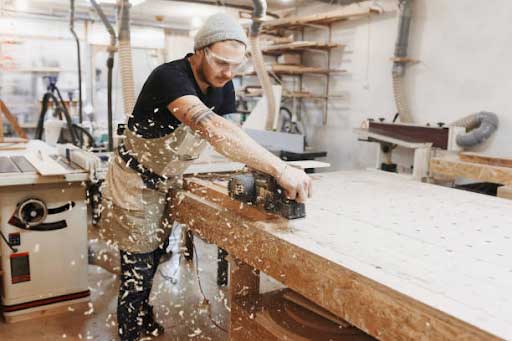Wood, a vital material that adds natural beauty and strength, is essential to our daily lives. It has been crucial to human development and innovation throughout history. From sturdy structures to elegant furniture, wood contributes to the charm and functionality of contemporary society.
In woodworking and construction, there are two main categories of wood — Manufactured Wood and Solid Wood.
These two types represent unique manufacturing processes, characteristics, and applications. Manufactured wood, often known as engineered wood, combines various wood products to form composite materials.
Solid wood, on the other hand, refers to lumber obtained directly from trees without altering the natural wood grain. Each type embodies distinctive advantages and potential limitations.
The Basics of Solid Wood
Solid wood has been a staple in construction, furniture making, and many other applications for centuries because it has a natural beauty, durability, and versatility.
Unlike manufactured wood, solid wood is lumber cut directly from the tree and not engineered or pieced together with any adhesives or materials.
It holds the original integrity of the wood, showcasing the species’ unique grain patterns, colors, and textures, which many find incredibly desirable.
Solid wood varies widely in density, color, and grain, depending on the tree species from which it is harvested. This inherent diversity ensures that no two pieces of solid wood are identical, giving each piece a unique aesthetic rich in character and history.
Types of Solid Wood
Hardwoods
These are derived from broad-leaved trees and are typically denser, making them ideal for applications where durability and longevity are essential. Examples of hardwoods include oak, maple, walnut, and cherry.
These woods are often used in high-end furniture, flooring, and cabinetry due to their sturdiness and distinctive appearance.
Softwoods
This is sourced from coniferous trees such as pine, cedar, and spruce, softwoods are generally lighter and more pliable than hardwoods. They are commonly used in construction, particularly for framing and producing outdoor furniture and decking, because of their resistance to rot and pests.
The more porous nature of softwood also makes it a good insulator, which is another reason for its use in the construction industry.
Exotic Woods
These are typically sourced from tropical climates and include mahogany, teak, and ipe species.
Often prized for their striking patterns and exceptional hardness, exotic woods are commonly used in specialty applications, such as making musical instruments, luxury flooring, and artisan furniture.
Exotic woods are more expensive due to their rarity and the higher demand for unique characteristics.
Common Uses and Applications
- Furniture Making: The strength and beauty of solid wood make it the preferred choice for heirloom-quality furniture.
- Construction: While more expensive than manufactured wood, solid wood is used for its structural integrity and aesthetic appeal, particularly in exposed beams and architectural details.
- Flooring: Hardwood flooring is a sought-after surface for homes and businesses due to its longevity and the warmth it adds to a space.
- Cabinetry and Woodwork: The integrity of solid wood ensures that the cabinetry doors hang correctly and that the surfaces maintain their form without deformation over time.
- Decorative Details: Carvings, turnings, and moldings benefit from the fine grain and workable nature of solid wood.
The Basics of Manufactured Wood
Manufactured wood, often engineered wood, is the modern solution to many construction and manufacturing challenges.
It encompasses a range of products created by binding the strands, particles, fibers, or wood veneers together with adhesives or other fixation methods to form composite materials.
The result is a synthesized product designed to optimize the natural properties of wood while expanding its applications.
Types of Manufactured Wood
Plywood
It comprises multiple layers of wood veneers that are glued and pressed together, with each layer’s grain oriented perpendicular to the adjacent layers. This cross-graining technique enhances strength, reduces the risk of expansion, and allows for larger sizes that are resistant to warping.
Medium-Density Fiberboard (MDF)
Made from wood fibers that are combined with resin and wax and then pressed into panels under high temperature and pressure. MDF is known for its smooth surface, free from knots, making it ideal for painting and intricate cuts.
Particle Board
This board is constructed from wood chips, sawmill shavings, or even sawdust, and a synthetic resin or other binder, which are pressed and extruded. This concoction is then subjected to pressure and extrusion to form panels. Particle board is the most affordable type of manufactured wood, often used in budget furniture and cabinetry.
Oriented Strand Board (OSB)
Fabricated from compressed layers of wood strands in specific orientations, OSB has superb load-bearing properties and is often used as a cost-effective alternative to plywood, particularly in roofing, flooring, and wall sheathing.
The modern approach to wood-based construction effectively capitalizes on manufactured wood’s uniformity, stability, and versatility.
Engineered wood products are meticulously crafted to meet exacting standards, ensuring consistency in strength and size, thus providing an efficient and reliable building material.
Common Uses and Applications
- Architectural Millwork: Manufactured wood products like MDF are extensively used for trim, moldings, and detailed work where a smooth finish is desired.
- Furniture Manufacturing: Due to its cost-effectiveness and adaptable surfaces, manufactured wood forms the backbone of mass-produced furniture. It allows for complex, repeatable designs that might be challenging to achieve with solid wood.
- Structural Applications: Products like OSB and plywood are the materials of choice for structural uses in residential and commercial construction. Their enhanced resistance to splitting, shrinking, and warping makes them ideal for sheathing in walls, floors, and roofs.
- Cabinetry: Particle board, often veneered or laminated, is a kitchen and bathroom cabinetry staple. Its homogeneity ensures that the cabinet doors hang straight and the surfaces do not bow or have inconsistencies.
- Flooring Underlayment: Plywood and OSB are stable bases for flooring materials, providing a uniform and durable platform upon which to lay decorative flooring options, including tile, hardwood, and carpet.
Comparing Physical Properties
When comparing the physical attributes of solid wood and manufactured wood, several key factors—such as strength and durability, weight, reaction to moisture and temperature, and overall lifespan—stand out. These factors are crucial in determining which type of wood will be suitable for various applications.
Strength and Durability
Solid wood is known for its outstanding strength and durability owing to its unaltered natural fibers and consistent grain pattern. Its robustness makes it the material of choice for applications requiring structural integrity, such as load-bearing furniture or high-traffic flooring.
Conversely, manufactured wood products, while engineered for a variety of uses, can sometimes lack the sheer resilience of solid wood because they are composed of wood fibers, chips, or layers bonded with adhesives.
Weight Considerations
The weight of wood is a significant factor in both transport and construction. Solid wood, given its density, particularly in the hardwood category, is generally heavier.
This characteristic can add to the cost and effort needed in handling and can impact decisions based on the design of movable furniture. Manufactured woods, designed with practicality in mind, often provide lighter solutions.
Materials like particleboard are considerably lighter, facilitating easier transportation and maneuverability—a clear advantage for certain applications, particularly in flat-pack furniture and modular cabinetry systems that consumers may assemble and reassemble themselves.
The Influence of Moisture and Temperature
Moisture and temperature fluctuations are critical factors in the longevity and stability of wood products.
Solid wood is hygroscopic, absorbing and releasing moisture based on the environment. This can cause occasional issues like warping or cracking due to expansion and contraction.
In contrast, manufactured wood, such as plywood or MDF, offers improved resistance to moisture-related issues. Engineered for enhanced stability, it reduces the risk of warping or cracking, making it a preferred choice in fluctuating environments.
This natural response to humidity can occasionally result in warping or cracking.
Lifespan and Wear Over Time
Renowned for its longevity, solid wood often lasts for generations. Well-maintained solid wood furniture or flooring can appreciate in value over time. The ability to sand and refinish contributes to its extended lifespan, allowing for surface rejuvenation even after decades of use.
While not matching the centuries-long lifespan of solid wood, manufactured wood products offer advantages in uniformity and consistency. Engineered with layers resistant to warping, they provide a stable foundation over time. However, the ability to refinish is generally limited compared to solid wood.
The choice between solid wood and manufactured wood depends on specific preferences, environmental considerations, and the intended use of the wood product.
While solid wood boasts time-tested longevity and the potential for refinishing, manufactured wood offers enhanced resistance to moisture-related challenges and a more uniform structure. Ultimately, both types of wood have their merits and are suitable for various applications based on individual needs and priorities.
Practical Applications and Suitability
Solid wood is the esteemed choice for timeless cabinetry and flooring, owing to its durability and repairability.
In contrast, manufactured wood is favored for structural work due to its uniform strength and cost-effectiveness.
The selection between the two often hinges on the local climate and the specific environmental conditions of a site.
Solid wood requires advanced woodworking skills for manipulation, whereas manufactured wood offers ease of use, catering to professionals and amateurs alike.
Market Trends and Consumer Preferences
The market is witnessing a rapidly growing preference for sustainable and eco-friendly furniture, with a clear trend toward using reclaimed solid wood in construction and DIY projects.
Consumer awareness regarding environmental impact and product quality is increasingly shaping the industry.
Nonetheless, the dichotomy of authenticity versus affordability continues to influence consumer choices, as some prioritize the unique appeal of solid wood, while others lean towards the economic benefits of manufactured wood products.
Choosing Between Manufactured Wood and Solid Wood
The choice between manufactured wood and solid wood is contingent upon the project’s nature, environmental considerations, budgetary constraints, and aesthetic desires.
Manufactured wood offers a cost-efficient, consistent, and sustainable option, particularly suited for structural applications and situations where uniformity is paramount.
Solid wood, however, reigns supreme in terms of durability, repairability, and classic beauty, making it the preferred choice for heirloom-quality furniture and projects where appearance and longevity are critical.
Weighing the attributes and drawbacks of each will inform a decision that aligns with functional requirements and personal values, ensuring the success and satisfaction of any woodworking endeavor.
Visit Keller Wood Products, the pioneering authority in molded plywood with over 75 years of excellence. With Keller Wood Products, customers gain access to a wealth of knowledge and expertise in both manufactured and solid wood, enabling a wise and informed choice.

